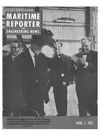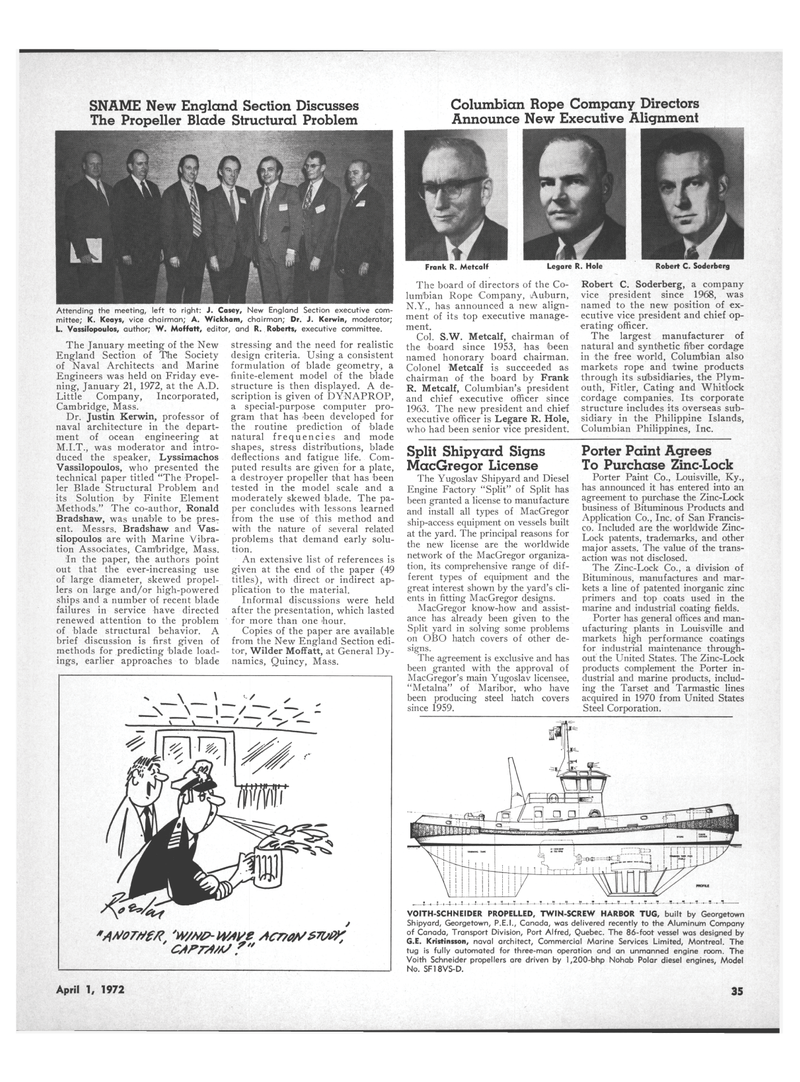
Page 25: of Maritime Reporter Magazine (April 1972)
Read this page in Pdf, Flash or Html5 edition of April 1972 Maritime Reporter Magazine
SNAME New England Section Discusses
The Propeller Blade Structural Problem
Attending the meeting, left to right: J. Casey, New England Section executive com- mittee; K. Keays, vice chairman; A. Wiekham, chairman; Dr. J. Kerwin, moderator;
L. Vassilopoulos, author; W. Moffatt, editor, and R. Roberts, executive committee.
The January meeting of the New
England Section of The Society of Naval Architects and Marine
Engineers was held on Friday eve- ning, January 21, 1972, at the A.D.
Little Company, Incorporated,
Cambridge, Mass.
Dr. Justin Kerwin, professor of naval architecture in the depart- ment of ocean engineering at
M.I.T., was moderator and intro- duced the speaker, Lyssimachos
Vassilopoulos, who presented the technical paper titled "The Propel- ler Blade Structural Problem and its Solution ;by Finite Element
Methods." The co-author, Ronald
Bradshaw, was unable to be pres- ent. Messrs. Bradshaw and Vas- silopoulos are with Marine Vibra- tion Associates, Cambridge, Mass. 'In the paper, the authors point out that the ever-increasing use of large diameter, skewed propel- lers on large and/or high-powered ships and a number of recent blade failures in service have directed renewed attention to the problem of blade structural behavior. A brief discussion is first given of methods for predicting 'blade load- ings, earlier approaches to blade stressing and the need for realistic design criteria. Using a consistent formulation of blade geometry, a finite-element model of the blade structure is then displayed. A de- scription is given of DYNAPROP, a special-purpose computer pro- gram that has 'been developed for the routine prediction of blade natural frequencies and mode shapes, stress distributions, blade deflections and fatigue life. Com- puted results are given for a plate, a destroyer propeller that has been tested in the model scale and a moderately skewed blade. The pa- per concludes with lessons learned from the use of this method and with the nature of several related problems that demand early solu- tion.
An extensive list of references is given at the end of the paper (49 titles), with direct or indirect ap- plication to the material.
Informal discussions were held after the presentation, which lasted for more than one hour.
Copies of the paper are available from the New England Section edi- tor, Wilder Moffatt, at General Dy- namics, Quincy, Mass. "AMTtfe/t, 'w/MP-iwve ACT/M/
April 1, 1972
Split Shipyard Signs
MacGregor License
The Yugoslav Shipyard and Diesel
Engine Factory "Split" of Split has been granted a license to manufacture and install all types of MacGregor ship-access equipment on vessels built at the yard. The principal reasons for the new license are the worldwide network of the MacGregor organiza- tion, its comprehensive range of dif- ferent types of equipment and the great interest shown by the yard's cli- ents in fitting MacGregor designs.
MacGregor know-how and assist- ance has already been given to the
Split yard in solving some problems on OBO hatch covers of other de- signs.
The agreement is exclusive and has been granted with the approval of
MacGregor's main Yugoslav licensee, "Metalna" of Maribor, who have been producing steel hatch covers since 1959.
Porter Paint Agrees
To Purchase Zinc-Lock
Porter Paint Co., Louisville, Ky., has announced it has entered into an agreement to purchase the Zinc-Lock business of Bituminous Products and
Application Co., Inc. of San Francis- co. Included are the worldwide Zinc-
Lock patents, trademarks, and other major assets. The value of the trans- action was not disclosed.
The Zinc-Lock Co., a division of
Bituminous, manufactures and mar- kets a line of patented inorganic zinc primers and top coats used in the marine and industrial coating fields.
Porter has general offices and man- ufacturing plants in Louisville and markets high performance coatings for industrial maintenance through- out the United States. The Zinc-Lock products complement the Porter in- dustrial and marine products, includ- ing the Tarset and Tarmastic lines acquired in 1970 from United States
Steel Corporation.
VOITH-SCHNEIDER PROPELLED, TWIN-SCREW HARBOR TUG, built by Georgetown
Shipyard, Georgetown, P.E.I., Canada, was delivered recently to the Aluminum Company of Canada, Transport Division, Port Alfred, Quebec. The 86-foot vessel was designed by
G.E. Kristinsson, naval architect, Commercial Marine Services Limited, Montreal. The tug is fully automated for three-man operation and an unmanned engine room. The
Voith Schneider propellers are driven by 1,200-bhp Nohab Polar diesel engines, Model
No. SF18VS-D. 35
Columbian Rope Company Directors
Announce New Executive Alignment
The board of directors of the Co- lumbian Rope Company, Auburn,
N.Y., has announced a new align- ment of its top executive manage- ment.
Col. S.W. Metcalf, chairman of the board since 1953, has been named honorary board chairman.
Colonel Metcalf is succeeded as chairman of the board by Frank
R. Metcalf, Columbian's president and chief executive officer since 1963. The new president and chief executive officer is Legare R. Hole, who had been senior vice president.
Robert C. Soderberg, a company vice president since 1968, was named to the new position of ex- ecutive vice president and chief op- erating officer.
The largest manufacturer of natural and synthetic fiber cordage in the free world, Columbian also markets rope and twine products through its subsidiaries, the Plym- outh, Fitler, Cating and Whitlock cordage companies. Its corporate structure includes its overseas sub- sidiary in the Philippine Islands,
Columbian Philippines, Inc.
Frank R. Metcalf Legare R. Hole Robert C. Soderberg

 24
24

 26
26
